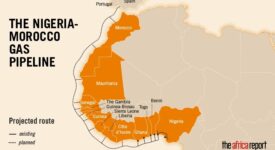Egypt, Algeria, Tunisia, and Morocco will soon be selling power to Europe. All four North African economies have invested tens of billions of dollars in green energy projects – particularly solar power – as a springboard to drive their energy ambitions. By taking advantage of the Saharan sun, the four countries are hoping to reduce the cost of solar technology, create cleaner environments, and support the creation of new business and investment opportunities.
Tunisia’s biggest solar energy project – TuNur – will become a new intercontinental corridor between North Africa and Europe by delivering power to Italian and French households. The $10.7 billion, 2500 megawatts project will utilize a high-voltage direct current to link to European grids as far away as the UK. In Morocco, the Noor Ouarzazate project, considered the world’s largest solar plant, is expected to be completed in 2018 for a total cost of $9 billion.
Egypt’s 150 MW Kuraymat solar power built in 2010 already supplies power to almost 2 million people. Analysts predict that all these projects demonstrate a huge potential in terms of solar power for the continent. “Solar energy is an emerging opportunity that cannot be ignored,” says Zandre Campos, chief executive of ABO Capital, an Angola-based fund, which invests in energy, agriculture, and technology. Mr. Campos said that the North African economies were “true innovators” for spearheading these renewable energy projects.
Observers add that to make a full use of these efficient systems in African countries, the region will need to boost public-private partnership. Morocco serves as an example for many North African countries and even beyond. The Kingdom has gone green by banning plastic bags and setting up ambitious goals to crack down on emissions. In 2012, the government also phased out fossil fuels subsidies and shifted focus on green energy.







